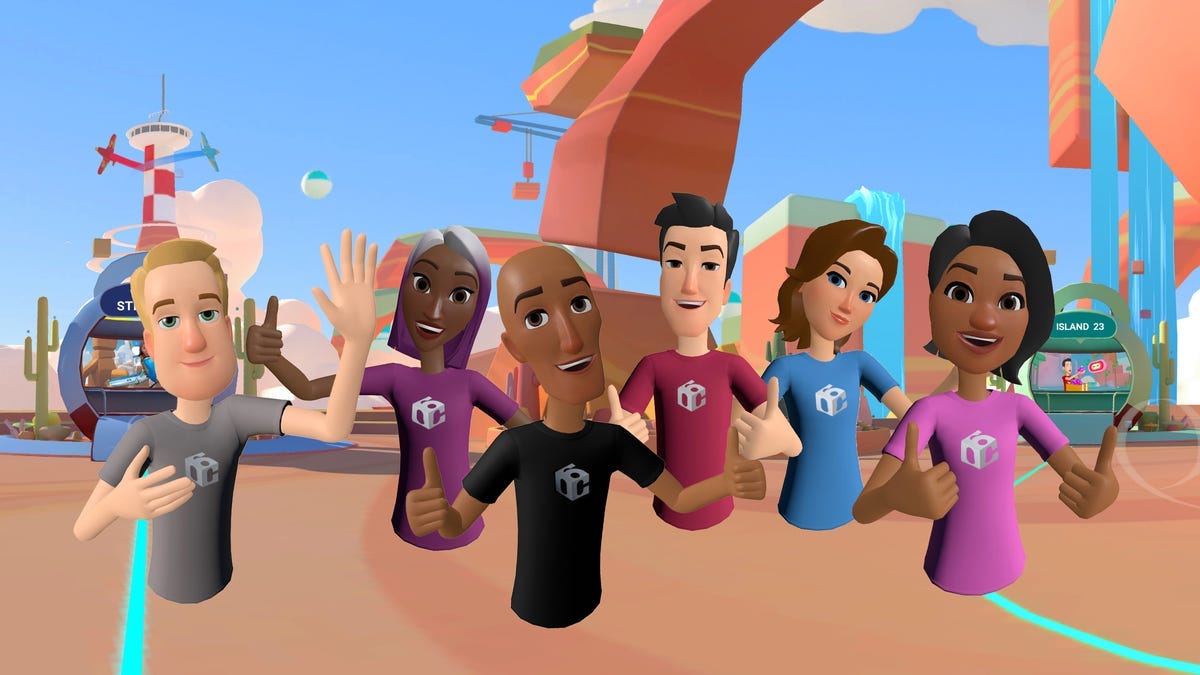[UPDATED] We're already living in the metaverse, you just can't see it yet.
A primer on the metaverse plus a mindset that makes you stronger
Re-sending because an important paragraph was missing from the antifragile section! Thanks for those who pointed it out 🙏.
Hey,
I hope I didn’t lose you after last week’s dive into the quantum realm. It’s a bit intense! This week we entered the metaverse as we explored the potential of AR and VR technology.
Students learned about up-and-coming companies competing in the race to own the metaverse as well as companies building hardware for both Augmented and Virtual reality. I even brought in a guest speaker to talk about how the metaverse might affect jobs or specific industries, though we got a bit sidetracked with our discussions on generative AI.
If this is all new to you, don’t worry. I’ve written you a primer. And after that, a mindset we teach the kids to help them grow even faster.
The metaverse is a topic I’m excited about so it’s a long email this time around.
The meta what?
There is an ongoing fight within the tech world to create the first digital immersive universe known as the metaverse. This new place will be where we socialize, play, and even work. Meta (fitting, I know) is winning the headlines when it comes to the actual metaverse itself, but many other players are joining in to create technology to support this vision such as HTC, Snapchat, and even Apple.
Augmented reality and virtual reality are key technologies used to create these immersive experiences. I haven’t described the metaverse in-depth yet, and that’s intentional. Let’s start instead with the technologies that might be used.
Gotta catch ‘em all
Late in the summer of 2016 and into 2017, hordes of people started walking around outside staring at their phones. But Steven, you say, people always do that. They still do that.
I know!
But this time was different.
People were walking around more than usual and exploring their cities. Staring at their phones was making them active. Why?
In 2016 Niantic launched Pokemon GO, an incredibly popular mobile game taking advantage of the Pokemon IP. Players roamed the real world looking for Pokemon who were scattered throughout. You could hold up your phone and see the pokemon in your physical surroundings. For a lot of people, this was their first exposure to Augmented Reality and potentially even an early perspective on the metaverse.
The best way to think about augmented reality is as a digital, visual layer on top of your physical environment.
This is deliberately broad because they are so many different incarnations of this. Think Snapchat filters. Placing IKEA furniture digitally in your home. When I was painting our dining room last year, I used this terrible app by Sherwin-Williams so I could visualize our room with a variety of paint colours. It was a basic but handy use of augmented reality.
Today, most AR experiences reside within your smartphone because most people have the devices already and most AR experiences aren’t worth getting new hardware.
How to think about augmented reality
The wrong view of augmented reality, likely due to the launch of Google Glass, was another screen where you could record content and get notifications. This is not what people needed. It's better to think about AR as a tool you keep in your pocket, only there when you need it. A bit more like Siri than Samantha from Her. You could ask Siri or your AR a specific question and it will show you contextual information, annotating your world.
Is this avocado ripe yet? (something I struggle with all the time)
How many calories are on my plate?
What song is this?
What type of cloud is that?
As you think about those questions and how your device might answer, try to get out of headset-mode. It’s still AR and it’s still valuable, even if it’s happening on your phone! The thing about AR is it doesn't need to be a wearable device. Your phone can already do these things, layering information over a photo or video feed.

Augmented Reality is already here, it just needs to get smaller and more integrated. Today we have things like your smartphone or the Microsoft Hololens. But in the future, we could have sleeker hardware or even AR-enabled contact lenses. Our cyborg future is fast approaching.
Augmented reality quick-hits
Magic Leap was a uber-hyped startup for the last ~7 years after their original demo video. Sadly they burned bright and fast, raising too much funding and essentially having to hit reset. They have since released their new goggles, focused on the enterprise. Imagine waking up from surgery and seeing your surgeon wearing these 😂
Microsoft’s Hololens is one of the industry-leading products but is SUPER expensive. It’s mostly targeted toward high-end users or businesses with prices in the $3k-5k range. They highlight use cases like manufacturing and healthcare.
Snapchat has released Spectacles, their AR hardware, that allows you to record the world and enter specific AR experiences. They are one of the few to take the consumer-first angle. If you want to build something for Spectacles, I encourage you to apply for their creator program.
A whole new (virtual) world
Unlike augmented reality, virtual reality (VR) is about putting on the headset and entering a brand-new world. It’s a fully immersive experience that takes over reality and replaces it with a new fabricated environment. It's a fully digital experience to do specific things: working, playing, and more. Sounds like my first description of the metaverse right?
This is why a lot of people instantly associate VR with the metaverse. And for the longest time, I thought of VR as the end goal and AR as a simple stepping stone to get there. Now I see that as a backward view → I think integration within reality is the best use of technology, not a replacement of it. VR will have its place, but to me, AR is the future.
OK. Let’s not skip over virtual reality too much as it’s still key. By putting on a headset you can enter a fully constructed environment, making this great for specific types of experiences.
Therapy: Some researchers and clinics are trying out VR Therapy, allowing patients to get exposure to specific triggers or even to create calming states that will allow patients to relax.
Entertainment: The go-to for most VR experiences, there are countless games and social hangouts in the entertainment realm. Something about seeing your friend or their avatar in VR makes you feel a bit closer to them than just having a voice or video chat. Around 2015 I was working on a potential VR project where our client wanted to explore having a collaborative movie-viewing experience; you and your friends would enter a VR theatre where a regular movie would be screened, but it was like you were all sitting there together.
Travel: One of the trends that we are starting to see (kudos to Scott King, our guest speaker) is that people are more hesitant to travel. They want to make sure they don’t waste money on their trip, especially after years of restrictions and lockdowns. VR can provide a perfect taster, allowing travellers to “sample” their destination ahead of booking a flight and feel more confident about spending their money.

The major devices out right now are the HTC Vive Pro 2, the Meta Quest Pro, and the Meta Quest 2. There are a few companies such as HoloKit are creating high-end versions of the Google Cardboard approach – a viewer that uses your smartphone as the core engine of the VR experience.
Ok, ok, back to the metaverse
We can't talk about AR and VR without also talking about the metaverse.
Many experts believe there will be a unified place where socialize, play, and work online. As if Zoom wasn't enough.
In some ways, we already have a metaverse, just not the way tech companies would have you believe. We spend most of our existence online: making friends (social media), playing (video games), and working (Zoom, Slack, Teams). We take on somewhat altered identities in these spaces and get completely immersed as we participate. We have layers of data created around our every move thanks to smartphones and wearables.
Are these not the metaverse?
Most big companies will argue no, but it’s in their best interest to do so. There seem to be a couple of fundamental assumptions they believe:
There can/should be a single metaverse.
It needs to be immersive (read: in VR).
But what if the metaverse is like the internet?
Phase 1: It starts with something you "log on to" (dial-up days) and something you can choose to leave. This is where most companies are thinking.
Phase 2: The metaverse becomes more prominent: it's embedded into our lives and something we start to use more regularly. Pretty soon after the dotcom boom, you couldn't do most jobs knowledge-work jobs without the internet. It's possible the metaverse follows this.
Phase 3: Lastly, like the internet, the metaverse becomes invisible. With the proliferation of devices, the internet is just everywhere and not something we really think about. It's taken for granted that if you have a computer, you're on the Internet. Same with your smartphone.
What if the metaverse was like this?
What if the metaverse is already like this?
I believe the fundamental differences in the view of the metaverse future are based on the split between the two types of tech. This is me putting words in their mouths, but here’s how I'm understanding it is
VR companies would have you believe you need to put a headset on to experience the metaverse. They think the metaverse is a digital place you go to with VR.
AR companies tell you that the metaverse is already around you, you just need an AR headset to see it. In this view, the metaverse is a physical place, augmented with technology.
I'm in the AR camp. I believe AR is a better future for immersive tech and that VR, for most things, will remain in the entertainment space. Sure there are specific use cases that might be valuable, but immersion isn't always what we are optimizing for.
Don't get me wrong, I still want a VR headset 😅. You'll probably see me getting an Apple one when it launches, so long as I can afford it.
How about you? What form of reality do you prefer?
What doesn’t kill you makes you stronger: Antifragility
I always thought it was Kelly Clarkson who coined this iconic phrase. Turns out it was Nietzsche. TIL.
Imagine you had a cup made of a special material called fragilium. It looked like a normal cup, it held water, but it was pretty thin. It’s like 2mm thick when you first bought it.
One day you’re drinking your morning coffee and you accidentally nudge it off the desk. It falls to the ground and makes a heavier sound than you expected. You pick it up and check it out: no cracks, phew. You look a little closer and you see the cup actually got thicker. It’s about 3mm thick now. Somehow it got stronger from the fall.
This cup would be considered antifragile.
Coined by author, mathematician, and Twitter troll Nassim Taleb (Black Swan, Skin in the game), antifragility is a term to describe things that grow from disorder or volatility. He describes how stressors and information can lead something to either break (fragile), survive (robust), or growth (anti-fragile).
Of course, this cup does not exist. Antifragility is such a non-intuitive idea because few physical objects are antifragile. Some trees create reaction wood in response to wind and stress, allowing them to become stronger and withstand additional pressure. Our muscles are also antifragile – we apply heavy amounts of stress to them to allow them to grow stronger. Our immune systems function in a similar way.
Alternatively, there are systems or personal qualities that are antifragile.
If you’re in a relationship and you have an argument or fight, you might grow as a couple. But, you can just as likely end the relationship or find yourselves in survival mode, just trying to ignore the topic until the emotions have tempered. This reveals something interesting about antifragility: antifragility is not a property of an object or system; it’s a response. The same stressor can lead to different impacts depending on how you choose to react.
For students, this becomes most obvious with feedback. If our goal is to grow and improve our skills and capabilities, feedback becomes a critical ingredient to our success. If we are antifragile, we can take that feedback (stressor) and use it to grow and get better the next time around. If we are fragile or resilient, that same feedback might cause us to shut down and give up, or simply ignore it and assume the speaker had a grudge.
There’s so much more to antifragility but I’m worried I’ve droned on too long. If you’re curious to learn more, I really enjoyed the above video by researcher Luca Dellanna as well as this article by Alex Danco.
A personal challenge
If you’re looking to become more antifragile, here’s a challenge for you.
Start by identifying where you are fragile. What are some areas of your life you're fragile?
Next, figure out where you want to change. What are some areas you want to be antifragile in?
Plot a path for growth. Instead of asking yourself “how can I become more antifragile” (not-actionable), ask yourself:
How do I respond to different stressors?
How can I become more likely to survive it?
How can I make it more likely to benefit from it?
It sounds simple, but like we talked about last week with Stoicism, being prepared will make it more likely you act how you want in some of these stressful situations.
PHEW!
Okay. This felt like a long one.
If you made it this far, I’m grateful. If you learned something new or found something interesting, do me a favour and tell someone about it! It could be about the mindset, the metaverse, or just this newsletter. I really appreciate it.
Til next week!
✌🏼









